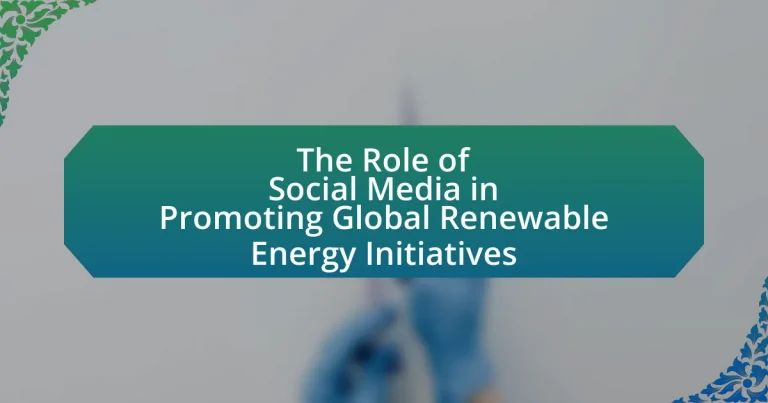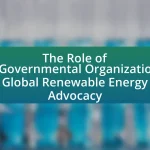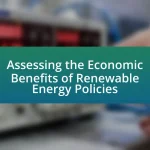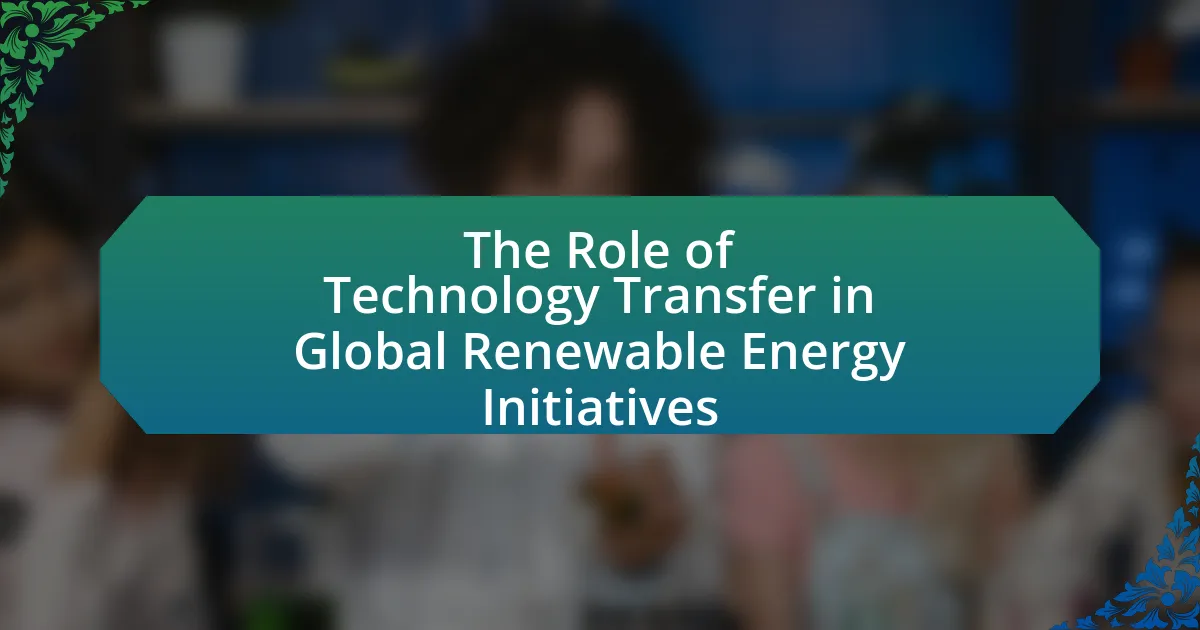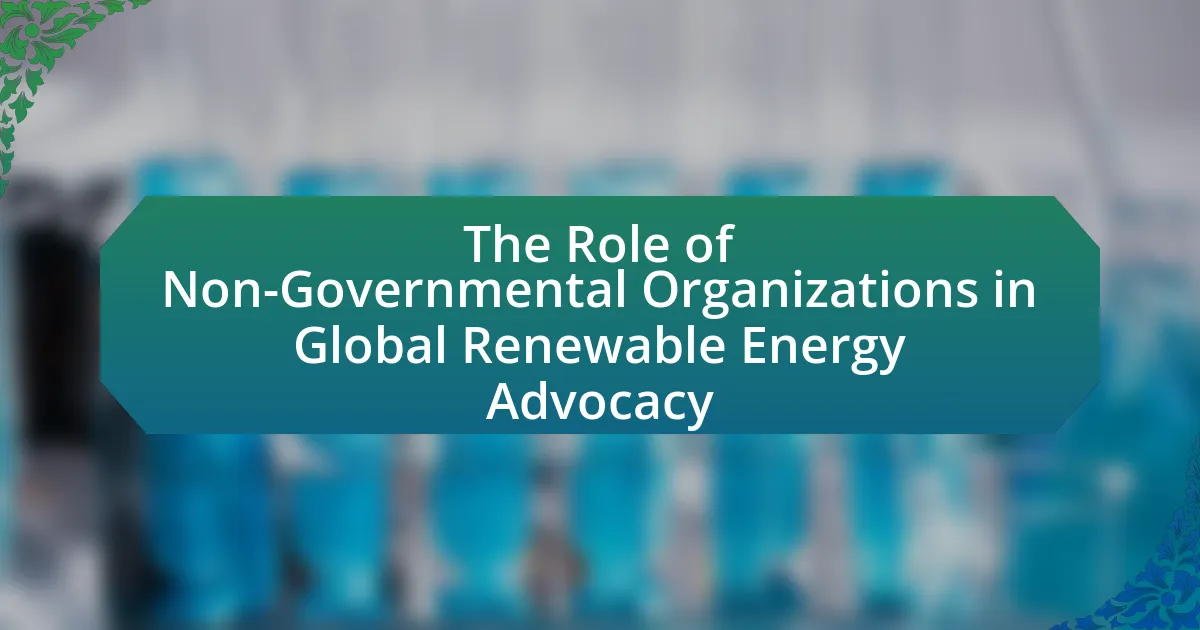The article examines the significant role of social media in promoting global renewable energy initiatives, highlighting its effectiveness in information dissemination, community engagement, and advocacy. It discusses how platforms like Twitter, Facebook, and Instagram facilitate the sharing of knowledge about renewable technologies and sustainability practices, mobilizing public support and influencing policy changes. Key benefits of social media include increased awareness, enhanced collaboration among stakeholders, and the ability to counter misinformation. The article also addresses challenges faced in this domain, such as skepticism and misinformation, while outlining strategies for effective social media campaigns and the importance of user-generated content in shaping public perception.
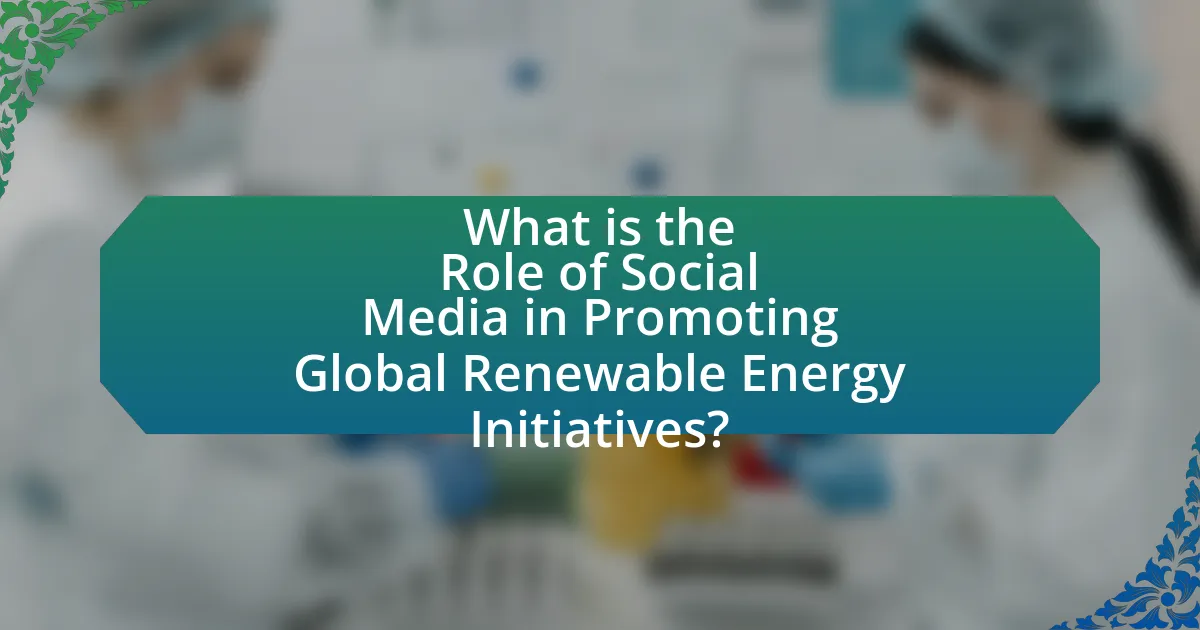
What is the Role of Social Media in Promoting Global Renewable Energy Initiatives?
Social media plays a crucial role in promoting global renewable energy initiatives by facilitating information dissemination, community engagement, and advocacy. Platforms like Twitter, Facebook, and Instagram enable organizations and individuals to share knowledge about renewable technologies, policy changes, and sustainability practices, reaching a global audience rapidly. For instance, campaigns such as #ActOnClimate have mobilized millions, raising awareness and influencing public opinion on climate action. Additionally, social media fosters collaboration among stakeholders, including governments, NGOs, and the private sector, enhancing the visibility of renewable energy projects and encouraging investment. According to a report by the International Renewable Energy Agency, social media campaigns have significantly increased public support for renewable energy policies in various countries, demonstrating its effectiveness as a tool for advocacy and education.
How does social media influence public awareness of renewable energy?
Social media significantly enhances public awareness of renewable energy by facilitating the rapid dissemination of information and fostering community engagement. Platforms like Facebook, Twitter, and Instagram allow organizations and individuals to share educational content, news, and personal experiences related to renewable energy, reaching a broad audience. For instance, a study by the Pew Research Center found that 69% of adults in the U.S. use social media, making it a powerful tool for spreading awareness about environmental issues. Additionally, campaigns that utilize hashtags and viral content can mobilize public interest and encourage discussions around renewable energy initiatives, leading to increased visibility and support for sustainable practices.
What platforms are most effective for promoting renewable energy initiatives?
Social media platforms such as Facebook, Twitter, Instagram, and LinkedIn are most effective for promoting renewable energy initiatives. These platforms facilitate widespread engagement and information sharing, allowing organizations to reach diverse audiences. For instance, Facebook’s targeted advertising capabilities enable renewable energy campaigns to connect with specific demographics interested in sustainability. Twitter serves as a real-time communication tool, where organizations can share updates and engage in conversations about renewable energy policies. Instagram’s visual nature allows for impactful storytelling through images and videos, showcasing renewable energy projects and their benefits. LinkedIn is particularly useful for professional networking, enabling industry leaders to share insights and foster partnerships in the renewable energy sector. Collectively, these platforms enhance visibility and foster community engagement around renewable energy initiatives.
How do social media campaigns increase engagement with renewable energy topics?
Social media campaigns increase engagement with renewable energy topics by leveraging interactive content and targeted messaging to reach diverse audiences. These campaigns utilize visual storytelling, infographics, and videos to simplify complex information about renewable energy, making it more accessible and relatable. For instance, a study by the Pew Research Center found that 69% of adults in the U.S. use social media, providing a vast platform for sharing educational content and fostering discussions around renewable energy. Additionally, social media allows for real-time feedback and community building, encouraging users to share their experiences and opinions, which further amplifies engagement.
Why is social media important for global renewable energy initiatives?
Social media is important for global renewable energy initiatives because it facilitates widespread awareness and engagement on sustainability issues. By leveraging platforms like Twitter, Facebook, and Instagram, organizations can disseminate information about renewable energy technologies, policies, and benefits to a global audience. For instance, a study by the International Renewable Energy Agency (IRENA) found that social media campaigns significantly increased public interest in renewable energy solutions, leading to higher adoption rates in various regions. Additionally, social media enables collaboration among stakeholders, including governments, NGOs, and the private sector, fostering partnerships that drive innovation and investment in renewable energy projects.
What are the key benefits of using social media for renewable energy advocacy?
The key benefits of using social media for renewable energy advocacy include increased awareness, enhanced community engagement, and the ability to mobilize support quickly. Social media platforms allow advocates to reach a global audience, disseminating information about renewable energy initiatives and their importance in combating climate change. For instance, campaigns on platforms like Twitter and Facebook can generate significant public discourse, as evidenced by the #FridaysForFuture movement, which has mobilized millions worldwide to advocate for climate action. Additionally, social media facilitates real-time interaction, enabling organizations to respond to inquiries and concerns, thus fostering a sense of community among supporters. This dynamic engagement can lead to increased participation in renewable energy projects and initiatives, ultimately driving policy changes and investment in sustainable technologies.
How does social media facilitate collaboration among stakeholders in renewable energy?
Social media facilitates collaboration among stakeholders in renewable energy by providing a platform for real-time communication, information sharing, and networking. This connectivity allows diverse groups, including government agencies, private companies, NGOs, and the public, to engage in discussions, share best practices, and coordinate efforts on renewable energy projects. For instance, platforms like Twitter and LinkedIn enable stakeholders to disseminate research findings, policy updates, and technological advancements quickly, fostering a collaborative environment. Additionally, social media campaigns can mobilize public support and raise awareness about renewable energy initiatives, further enhancing stakeholder collaboration.
What challenges does social media face in promoting renewable energy initiatives?
Social media faces significant challenges in promoting renewable energy initiatives, primarily due to misinformation and lack of engagement. Misinformation can spread rapidly on platforms, leading to public confusion about renewable energy technologies and their benefits. For instance, a study by the Pew Research Center found that 64% of Americans believe that misinformation on social media has a major impact on public opinion regarding climate change and energy policies. Additionally, social media platforms often struggle to maintain user engagement on complex topics like renewable energy, as users may prefer more entertaining or relatable content. This results in lower visibility for important initiatives, hindering their promotion and public support.
How do misinformation and skepticism impact renewable energy discussions on social media?
Misinformation and skepticism significantly hinder renewable energy discussions on social media by spreading false narratives and fostering doubt among users. For instance, studies show that misleading information about renewable energy technologies, such as solar and wind, can lead to public confusion and resistance to adopting these solutions. A 2021 survey by the Pew Research Center found that 48% of Americans expressed skepticism about the effectiveness of renewable energy sources, often fueled by misinformation campaigns that exaggerate costs or question reliability. This skepticism can result in decreased support for renewable energy policies and initiatives, ultimately slowing down the transition to sustainable energy systems.
What strategies can be employed to overcome these challenges?
To overcome challenges in promoting global renewable energy initiatives through social media, organizations can employ targeted content strategies, engage with influencers, and utilize data analytics. Targeted content strategies involve creating tailored messages that resonate with specific audiences, enhancing engagement and awareness. Engaging with influencers can amplify reach, as influencers often have established trust with their followers, making them effective advocates for renewable energy. Utilizing data analytics allows organizations to track engagement metrics and adjust strategies in real-time, ensuring that efforts are effective and aligned with audience interests. These strategies are supported by studies showing that targeted messaging increases user engagement by up to 50%, and influencer marketing can yield a return on investment of $6.50 for every dollar spent.
How can social media campaigns be effectively designed for renewable energy initiatives?
Social media campaigns for renewable energy initiatives can be effectively designed by focusing on clear messaging, audience engagement, and data-driven strategies. Clear messaging should highlight the benefits of renewable energy, such as sustainability and cost savings, to resonate with the target audience. Engaging content, including visuals and interactive elements, can capture attention and encourage sharing, which amplifies reach. Data-driven strategies involve analyzing audience demographics and preferences to tailor content that maximizes impact. For instance, a study by the Pew Research Center found that 72% of adults use social media, indicating a significant platform for outreach. Additionally, campaigns that utilize user-generated content can foster community involvement and enhance credibility, as seen in successful initiatives like the #SolarChallenge on Instagram.
What elements are essential for a successful social media campaign in this field?
Essential elements for a successful social media campaign in promoting global renewable energy initiatives include clear messaging, targeted audience engagement, and consistent content sharing. Clear messaging ensures that the campaign communicates the benefits and importance of renewable energy effectively, which is crucial for audience understanding and support. Targeted audience engagement involves identifying and interacting with specific demographics interested in sustainability, thereby increasing the campaign’s relevance and impact. Consistent content sharing, including updates, success stories, and educational materials, maintains audience interest and fosters community involvement. According to a study by the International Renewable Energy Agency, effective communication strategies significantly enhance public awareness and acceptance of renewable energy projects, demonstrating the importance of these elements in achieving campaign success.
How can metrics be used to measure the success of these campaigns?
Metrics can be used to measure the success of social media campaigns promoting global renewable energy initiatives by analyzing engagement rates, reach, conversion rates, and sentiment analysis. Engagement rates, such as likes, shares, and comments, indicate how well the content resonates with the audience, while reach measures the total number of unique users who see the campaign. Conversion rates track the percentage of users who take a desired action, such as signing a petition or donating, reflecting the campaign’s effectiveness in driving action. Sentiment analysis assesses public perception and attitudes towards the initiatives, providing insights into the campaign’s impact on audience opinion. These metrics collectively offer a comprehensive view of campaign performance, enabling organizations to adjust strategies for improved outcomes.
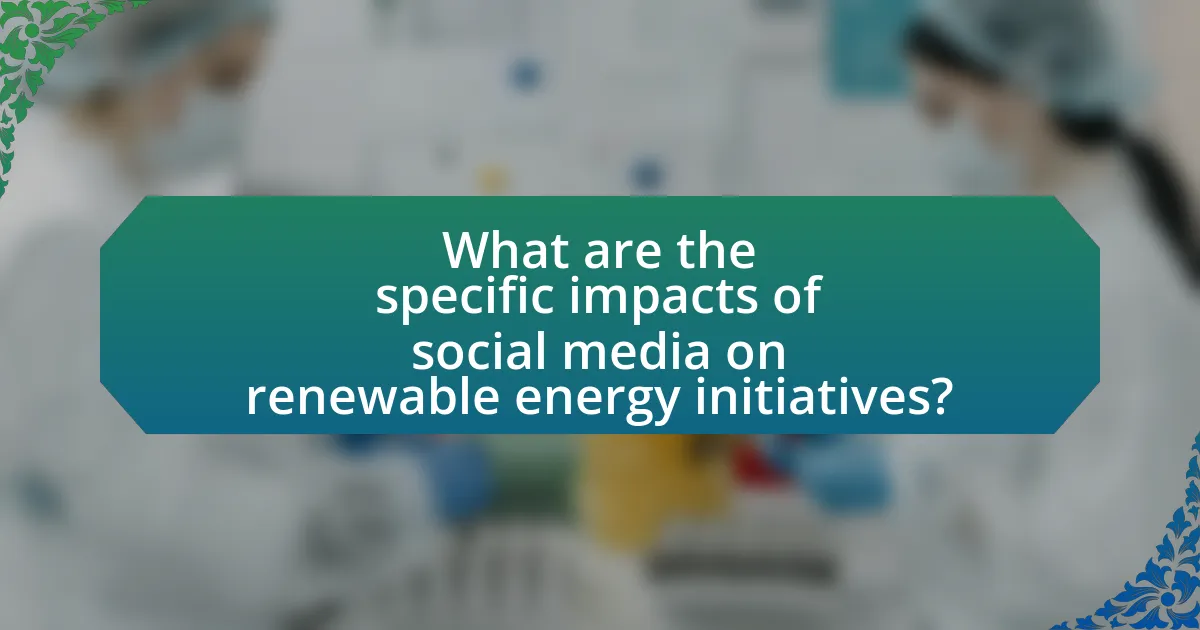
What are the specific impacts of social media on renewable energy initiatives?
Social media significantly impacts renewable energy initiatives by enhancing awareness, facilitating community engagement, and driving policy advocacy. Platforms like Twitter and Facebook allow organizations to disseminate information rapidly, reaching a global audience and educating the public about renewable energy benefits. For instance, a study by the International Renewable Energy Agency (IRENA) found that social media campaigns can increase public support for renewable projects by up to 30%. Additionally, social media fosters collaboration among stakeholders, enabling grassroots movements that influence local and national energy policies. This interconnectedness amplifies the voices of advocates, leading to increased funding and investment in renewable technologies.
How does social media drive policy changes in renewable energy?
Social media drives policy changes in renewable energy by amplifying public awareness and mobilizing grassroots movements. Platforms like Twitter and Facebook facilitate the rapid dissemination of information regarding renewable energy issues, enabling users to share data, success stories, and calls to action. For instance, campaigns such as #FridaysForFuture have successfully influenced policymakers by showcasing widespread public support for climate action, leading to commitments from governments to enhance renewable energy initiatives. Additionally, social media allows for real-time engagement between citizens and policymakers, creating pressure for legislative changes that prioritize renewable energy solutions.
What examples exist of social media influencing renewable energy legislation?
Social media has significantly influenced renewable energy legislation through campaigns that mobilize public opinion and pressure policymakers. For instance, the #FridaysForFuture movement, initiated by Greta Thunberg, has galvanized youth activism worldwide, leading to increased legislative focus on climate change and renewable energy policies in countries like Sweden and Germany. Additionally, social media platforms have been used to amplify grassroots campaigns, such as the “Stop the Dakota Access Pipeline” movement, which highlighted environmental concerns and led to legislative reviews regarding energy projects in the United States. These examples demonstrate how social media serves as a powerful tool for advocacy, shaping public discourse and legislative priorities in the renewable energy sector.
How do grassroots movements utilize social media for policy advocacy?
Grassroots movements utilize social media for policy advocacy by leveraging platforms to mobilize supporters, disseminate information, and influence public opinion. These movements create campaigns that engage users through targeted messaging, often using hashtags to unify their efforts and increase visibility. For instance, the #FridaysForFuture movement effectively utilized Twitter and Instagram to raise awareness about climate change, garnering millions of followers and prompting discussions that reached policymakers. Social media also enables grassroots organizations to share real-time updates, organize events, and facilitate direct communication with legislators, thereby enhancing their advocacy efforts.
What role does user-generated content play in promoting renewable energy?
User-generated content plays a crucial role in promoting renewable energy by fostering community engagement and spreading awareness. This type of content, such as personal stories, testimonials, and educational posts shared on social media platforms, helps to humanize the renewable energy narrative and makes it more relatable to the public. For instance, a study by the Pew Research Center found that 72% of social media users have engaged with content related to environmental issues, indicating a strong interest in renewable energy topics. Additionally, user-generated content can amplify messages from organizations and activists, creating a grassroots movement that encourages individuals to adopt sustainable practices and support renewable energy initiatives.
How can individuals contribute to renewable energy discussions on social media?
Individuals can contribute to renewable energy discussions on social media by sharing informative content, engaging in conversations, and promoting awareness about renewable energy issues. By posting articles, infographics, and personal insights, individuals can educate their followers on the benefits and challenges of renewable energy sources. Engaging in discussions by commenting on posts, asking questions, and sharing experiences can foster a community of informed individuals. Additionally, promoting campaigns or initiatives related to renewable energy can amplify the message and encourage collective action. Research indicates that social media can significantly influence public perception and policy regarding renewable energy, making individual contributions vital for broader awareness and advocacy.
What impact does user-generated content have on public perception of renewable energy?
User-generated content significantly influences public perception of renewable energy by fostering engagement and shaping narratives. This content, often shared on social media platforms, allows individuals to express their views, share experiences, and disseminate information about renewable energy initiatives. Research indicates that 79% of consumers trust user-generated content as much as personal recommendations, which enhances credibility and relatability. Furthermore, user-generated content can counter misinformation and highlight the benefits of renewable energy, leading to increased acceptance and support among the public. For instance, campaigns that encourage users to share their renewable energy experiences have shown to improve public awareness and positive sentiment towards sustainable practices.
How can organizations leverage social media for renewable energy initiatives?
Organizations can leverage social media for renewable energy initiatives by utilizing platforms to raise awareness, engage communities, and share educational content. For instance, organizations can create targeted campaigns that highlight the benefits of renewable energy, such as reduced carbon emissions and cost savings, which can resonate with audiences. According to a 2021 report by the International Renewable Energy Agency, social media campaigns can increase public engagement by up to 60%, demonstrating the effectiveness of these platforms in promoting renewable energy awareness. Additionally, organizations can collaborate with influencers in the sustainability sector to amplify their message and reach a broader audience, thereby fostering a community around renewable energy initiatives.
What best practices should organizations follow when using social media for advocacy?
Organizations should prioritize authenticity, engagement, and strategic messaging when using social media for advocacy. Authenticity builds trust; for instance, organizations that share genuine stories and experiences related to renewable energy initiatives can foster a deeper connection with their audience. Engagement is crucial; responding to comments and participating in discussions can enhance community involvement and support. Strategic messaging involves clearly defining goals and tailoring content to resonate with specific audiences, which can be evidenced by campaigns that successfully mobilized public support for renewable energy policies through targeted social media outreach.
How can partnerships enhance social media efforts in promoting renewable energy?
Partnerships can enhance social media efforts in promoting renewable energy by leveraging combined resources, expertise, and audiences to amplify messaging and outreach. For instance, collaborations between renewable energy companies and environmental organizations can create compelling content that resonates with diverse demographics, increasing engagement rates. According to a study by the Pew Research Center, 69% of adults in the U.S. use social media, making it a vital platform for disseminating information. By pooling their networks, partners can reach a broader audience, driving awareness and support for renewable energy initiatives. Additionally, partnerships can facilitate the sharing of best practices and innovative strategies, leading to more effective campaigns that can influence public opinion and policy.
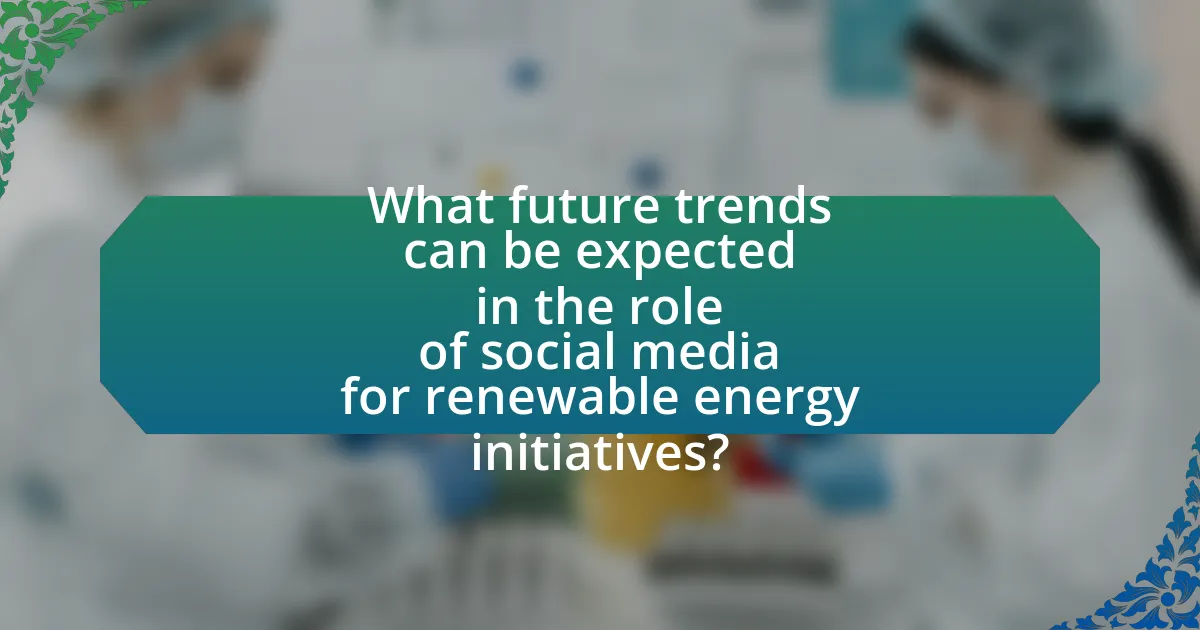
What future trends can be expected in the role of social media for renewable energy initiatives?
Future trends in the role of social media for renewable energy initiatives include increased engagement through interactive content, enhanced data analytics for targeted outreach, and the rise of influencer partnerships to amplify messaging. Social media platforms are evolving to support more immersive experiences, such as live-streaming events and virtual reality tours of renewable energy projects, which can educate and inspire audiences. Additionally, the use of advanced analytics will allow organizations to tailor their campaigns more effectively, reaching specific demographics interested in sustainability. Research indicates that influencer marketing can significantly boost awareness and credibility; for instance, a study by the Digital Marketing Institute found that 49% of consumers depend on influencer recommendations for their purchasing decisions. These trends suggest that social media will play a crucial role in shaping public perception and driving action towards renewable energy initiatives.
How is technology evolving to support social media’s role in renewable energy?
Technology is evolving to support social media’s role in renewable energy by enhancing data sharing, improving engagement tools, and facilitating real-time communication. Advanced analytics and artificial intelligence enable social media platforms to curate and disseminate relevant content about renewable energy initiatives, making it easier for users to access information. For instance, platforms like Twitter and Facebook utilize algorithms that promote posts related to sustainability, thereby increasing visibility for renewable energy campaigns. Additionally, the integration of live streaming and interactive features allows organizations to host virtual events and discussions, fostering community engagement and awareness. According to a report by the International Renewable Energy Agency (IRENA), social media campaigns have significantly increased public interest in renewable energy topics, demonstrating the effectiveness of these technological advancements in promoting global initiatives.
What emerging platforms may influence renewable energy discussions in the future?
Emerging platforms that may influence renewable energy discussions in the future include TikTok, Clubhouse, and decentralized social media networks like Mastodon. TikTok’s short-form video format allows for engaging content that can quickly spread awareness about renewable energy topics, as evidenced by viral campaigns that have successfully educated younger audiences. Clubhouse facilitates real-time discussions among experts and enthusiasts, fostering community engagement and knowledge sharing, which can drive innovative ideas in renewable energy. Decentralized networks like Mastodon promote user control and privacy, potentially attracting users concerned about corporate influence in energy discussions, thereby diversifying the dialogue around renewable energy initiatives.
How can advancements in data analytics improve social media strategies for renewable energy?
Advancements in data analytics can significantly enhance social media strategies for renewable energy by enabling targeted content delivery and audience engagement. By analyzing user behavior, preferences, and demographics, organizations can tailor their messaging to resonate with specific segments, increasing the likelihood of engagement. For instance, a study by the International Renewable Energy Agency (IRENA) found that targeted social media campaigns can improve outreach effectiveness by up to 50%. Furthermore, real-time analytics allow for the adjustment of strategies based on immediate feedback, optimizing content performance and maximizing reach. This data-driven approach not only improves engagement rates but also fosters a more informed public discourse on renewable energy initiatives.
What are the implications of social media trends for renewable energy advocacy?
Social media trends significantly enhance renewable energy advocacy by increasing public awareness and engagement. Platforms like Twitter and Instagram facilitate the rapid dissemination of information regarding renewable energy benefits, policies, and innovations, reaching diverse audiences. For instance, a study by the Pew Research Center found that 69% of adults in the U.S. use social media, providing a vast network for advocacy groups to share educational content and mobilize support. Additionally, trending hashtags related to climate change and renewable energy can amplify messages, leading to greater visibility and community involvement in sustainability initiatives. This engagement can translate into increased pressure on policymakers to prioritize renewable energy solutions, as evidenced by the rise in public support for clean energy policies following viral social media campaigns.
How can organizations adapt to changing social media landscapes for effective advocacy?
Organizations can adapt to changing social media landscapes for effective advocacy by continuously monitoring trends and audience engagement metrics. This approach allows organizations to tailor their messaging and strategies to align with the evolving preferences of their target demographics. For instance, a study by the Pew Research Center indicates that 69% of adults in the U.S. use social media, highlighting the importance of platforms like Instagram and TikTok for reaching younger audiences. By leveraging analytics tools, organizations can identify which platforms yield the highest engagement rates and adjust their content accordingly, ensuring that their advocacy efforts resonate with the audience. Additionally, organizations should embrace diverse content formats, such as videos and interactive posts, to enhance engagement and shareability, as visual content is known to increase user interaction by up to 94%.
What skills will be necessary for advocates in the future of social media and renewable energy?
Advocates in the future of social media and renewable energy will need skills in digital communication, data analysis, and strategic campaigning. Digital communication skills are essential for effectively engaging audiences across various platforms, as social media is a primary tool for outreach and education. Data analysis skills will enable advocates to interpret trends and measure the impact of their initiatives, ensuring that strategies are data-driven and effective. Strategic campaigning skills are crucial for developing targeted messages that resonate with diverse audiences, maximizing the reach and influence of renewable energy initiatives. These skills are supported by the increasing reliance on social media for advocacy, as evidenced by studies showing that campaigns utilizing data-driven strategies achieve higher engagement rates and greater public awareness.
What practical tips can enhance social media engagement for renewable energy initiatives?
To enhance social media engagement for renewable energy initiatives, organizations should utilize visually appealing content, such as infographics and videos, to effectively communicate complex information. Research indicates that posts with images receive 94% more views than text-only posts, making visual content crucial for capturing attention. Additionally, engaging storytelling that highlights personal experiences or community impacts can foster emotional connections, encouraging shares and interactions. According to a study by the Content Marketing Institute, storytelling can increase audience engagement by up to 300%. Regularly interacting with followers through comments, polls, and Q&A sessions also boosts engagement, as active participation can lead to a 50% increase in user interaction. Lastly, leveraging relevant hashtags can expand reach; for instance, using #RenewableEnergy can connect posts to broader conversations, increasing visibility and engagement.
How can content be tailored to resonate with diverse audiences interested in renewable energy?
Content can be tailored to resonate with diverse audiences interested in renewable energy by utilizing targeted messaging that reflects the specific values, interests, and cultural contexts of each audience segment. For instance, research indicates that younger audiences prioritize climate action and sustainability, while older demographics may focus on economic benefits and energy independence. By employing data-driven insights, such as demographic studies and social media analytics, content creators can craft messages that highlight renewable energy’s environmental impact for eco-conscious individuals and emphasize cost savings for budget-conscious consumers. Additionally, using relatable narratives and local case studies can enhance engagement, as evidenced by campaigns that successfully mobilized community support through localized storytelling.
What are effective ways to encourage community participation in renewable energy discussions on social media?
Effective ways to encourage community participation in renewable energy discussions on social media include creating engaging content, utilizing interactive features, and fostering a sense of community. Engaging content, such as infographics and videos, captures attention and simplifies complex information, making it more accessible. Interactive features like polls and Q&A sessions invite direct participation, allowing community members to voice their opinions and ask questions. Additionally, fostering a sense of community through dedicated groups or forums encourages ongoing dialogue and collaboration, as evidenced by studies showing that community-driven initiatives lead to higher engagement rates. For instance, a report by the Pew Research Center found that 69% of social media users are more likely to engage with content that feels personal and community-oriented.
